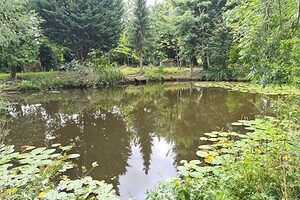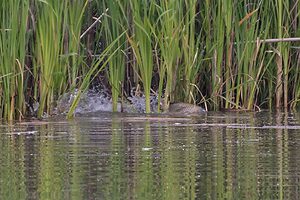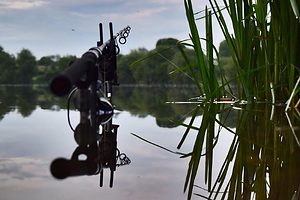Disclosure: Some posts contain affiliate links, which earn us a commission if you make a purchase through them. Positive Fishing © participates in various affiliate networks including the Amazon Services LLC Associates Program.
Margin fishing can be one of the most exhilarating ways of fishing. Hooking into a fish in these shallow areas, close to the bank, can make your heart thump.
Many rigs, methods, and baits are possible to use, and I’ll go through these in detail to give you more insights on how to catch more fish, especially carp, in the marginal areas.
In this article, I will cover the following:
- What Is Margin Fishing?
- How To Find Fish in the Margins?
- What Fish Are In The Margins?
- How To Fish In The Margins?
- Best Rigs to Use in the Margins?
- Best Bait to Use in the Margins?
- Tips for Success When Margin Fishing
- Final Thoughts
What Is Margin Fishing?

The margins are the shallow parts around the sides of a lake or river. These areas are prime fishing areas and are very often ignored by anglers. Many fish, such as carp and barbel, love to visit these margin areas for cover and protection but also for the free food offerings that drop or fall into the marginal areas.
How To Find Fish Fish In The Margins?
The margins are a bit more complicated than you would think. With some trial and error, you’ll find yourself landing quite a few fish without doing excessive work. Margin areas are shallow, sometimes only 6 inches to 3 feet deep, even right at the edge.
Start by Sight Fishing
When you first get to a body of water, the first thing you should do is fish with your eyes. Take a long walk around the lake, search the body of water as much as possible, and see what you can find.
Approaching the chosen fishing spot is critical. A pair of Fortis Wraps polarized sunglasses makes seeing the fish much easier. Surface glare will shield your view from the shallow margin area and may cause you to miss the perfect opportunity to sight some bigger fish.
Stalking In The Margins
The margins have plenty of reeds, bushes, and overhanging trees; these areas are prime margin areas. Look for bubbles or cloudy areas where the fish have disturbed the bottom. Also, look for fish you see rolling, and then you know that you should start fishing there.
Carp often feed in the margins as the water begins to warm. Stay quiet and stalk out the fish; hiding behind vegetation or bushes will prevent the carp from spotting you. While stalking fish and identifying any movement in those margins – keep quiet and out of sight as best as possible!
Fresh Vegetation Areas are Perfect
If you see smaller reeds popping out of the margins, you have a good chance of landing fish.
Carp often find themselves feeding in this fresh vegetation. It leads to bait and plant life, especially appealing to these fish. Carp will eat over 20% of their body weight daily; much of that food is fresh vegetation. You’ll see the reeds and plants moving as the fish traverse through them and look for food.
Hard Bottom is Good
If you can wade into the water, look to see where the bottom is a bit harder. Hard grounds make for better presentation and easy feeding for the fish.
The margins have a lot of loose twigs, leaves, and other debris. Among these areas, you can find clearer hard locations on the bottom, where the fish will have been feeding and continuously cleaning it.
You probably aren’t the first person fished in the area you’re fishing, so you could find bait that has recently fallen into the water! This bait is an easy target for fish! So try to mimic it with your own bait.
What Fish Are In The Margins?

Most anglers will fish for all types of carp in the margin areas. However, on many lakes, almost all fish will head for the margins several times during the day and even at night. Barbel, tench, and catfish also love to spend time by the water’s edge; they not only get natural cover but also find plenty of food in these areas close to the bank.
At the end of their fishing day, many anglers will throw any excess baits in the water at the edges – fish know they can get plenty of free offerings without having to search very long.
How to Fish In the Margins?
Get Ready to Fight
If you happen to trick a fish into taking your bait in the margins, you have to be ready for a good fight.
The first instinct of a hooked carp in shallow water is to head for deeper water. They will go hard and fast, so you must pin that drag fairly tightly. Be ready to keep that fish close and bring it into the net as fast as possible.
Don’t Be Afraid to Use your Hands
Now, you’re not going to be fishing with your hands, but since you’re fishing so close to the bank, you can use your hands to help place your bait in exactly the area you want to!
Whether you’re fishing with a float or a split shot rig, you can place the rig wherever you would like in the margins. Do your best not to disrupt too much of the environment, but placing your rig by hand can be a great strategic move as an angler!
Feel Free to Chum
When you’re fishing for carp, chumming is an accepted strategy. You want to wake up their appetites and get them used to feeding on the bait you’re going to be using. Pellets, boilies, corn, and bread are great margin baits, so feel free to use them to get yourself in a great position to land some of these fish.
It’s All About Angles
Since carp have phenomenal eyesight, you want to be as inconspicuous as possible. However, you don’t want your bait and line to be too obvious for these fish. As a result, you can stand very still in the water to give yourself a better angle at these fish.
Once you’re in the water, you aren’t going to want to be moving around. Stay still, place your bait and get ready to set the hook. This tactic can be especially useful if you want to get right under an overhanging tree you cannot cast to or reach whilst fishing from the bank.
Best Rigs to Use in the Margins?

bank near reeds can produce great carp catches.
You want as little disturbance as possible with your rig, but you want it to be extremely sensitive so that you can detect even the smallest nibble. Use a 6 to 10-pound test for your leader and size 10 to 12 hooks to keep the fish pinned.
The best carp rigs to use in the margins are simple rigs. Don’t overcomplicate your margin carp rigs; below are a few of the preferred tactics experienced anglers use.
Free Lining
You can free-line in the margins if you’re up for the challenge. Since you don’t have to make a long cast, drop your line into the water with a strong hook and some corn and wait to see what happens. You’ll find that this rig is extremely sensitive, and you have a great time trying to land the fish once it takes your bait.
Freelining dog biscuits and bread in this situation is a great way to catch carp. These floating baits can really entice the fish to bite, and this method is an entertaining way to catch carp.
Float Fishing
If you need a more finesse rig and aren’t overly comfortable freelining, using a float can give you a good chance at landing carp in the margins. You can throw a rig with an 8 to 10-pound test leader amongst feeding fish, and they won’t go off and feed elsewhere.
Stay patient when using a float, and do your best not to throw it directly on top of the fish. It’s best to cast past the area you want to fish in and slowly draw the float back towards you; this way, you can get right in amongst the fish.
A simple waggler setup is perfect, with the bait pinned to the bottom.
Use A Method Feeder
This is one of my favourite methods to use in the margins. A loaded method feeder with groundbait or margin mix filled with corn, maggots, and pellets works really well. It’s easy to cast underhand right on the spot you want to fish.
However, give yourself a decent length of line from the bait to your rod tip. If not, you risk losing the fish or a line break; typically, 12 to 15ft of line from the rod tip should be sufficient.
Margin Pole Fishing
If the above methods don’t give you that adrenaline you were expecting, then using a margin pole indeed will!
Pole fishing down the edge can really be challenging if you hook into a carp of over 10lbs. Having no reel makes the elastic that we choose extremely important. Once you have hooked into the fish, they will quickly move towards the nearest underwater structures, such as trees and tall reeds.
I strongly suggest you buy a dedicated margin pole such as the Preston Monster Edge margin pole; this pole is built specifically for the marginal areas and for catching big margin carp!
Best Bait to Use in the Margins?
Pellets
All regular carp baits will work in the margins. My personal favourite is with pellets of 8 to 10mm. Pellets are one of the most favoured baits you can use with a method feeder or a float rig.
Sweetcorn
Sweetcorn is always an easy bait to use. One or two kernels will stand out from the other groundbait and loose feed. Again, like pellets, they can be used on margin float setups or the method feeder.
Bread
Everyone uses bread for fishing, and I take a loaf with me whenever I go fishing. It’s an inexpensive and very adaptable option. Freelined bread crust on the surface in the margins is another popular option.
Maggots
Finally, we come to the most common bait every angler uses for all types of fishing – maggots. A bunch of maggots on your hook, wriggling around in these shallow margin areas, will always catch fish. The beauty of maggots is that you can use them in various rigs to catch margin carp.
Don’t Overfeed
Even when you’re ground baiting or chumming, please don’t get too eager and think that all that bait will guarantee they eat yours. You want them to want more and be eager to eat whatever you throw their way.
Carp aren’t afraid to live by the motto, “If it sounds too good to be true, it probably is.” It’s always best to expose your hook point, and you will hook up to more fish. Also, bait presentation needs to be good; make the bait on your hook look as natural as possible. Otherwise, the fish will likely get spooked instead of enticing them to eat it.
In summary, feed enough to entice them into the target area, but not overdo it as many anglers say; feeding little but often is better than too much at once.
Tips For Success When Margin Fishing

the best fishing spots – Always stay hidden.
If you’re new to margin fishing, start fishing in an area with fresh vegetation. Throw some chum in the water right next to where your baited hook is positioned.
Stay out of the way and let the fish do their thing with feeding. They’ll eventually come to you and eat yours.
You have to stay hidden! If a fish sees a shadow or looming figure over the water, it will be extremely hesitant to feed. Be careful during your approach and while you’re fishing. Try not to splash in the water, and do your best to keep your shadow on the bank.
If you don’t get any bites or interest in your bait after 15 minutes, move on to another spot. You can always come back to the first spot later.
Try different rig options; don’t use the same rig repeatedly if you are not getting any interested fish.
Final Thoughts
Remember, fish will patrol the margins daily, and it’s part of their natural route around the water to find food easily. Keep as quiet as possible, and you will succeed in these typically underfished areas.
I hope you enjoyed this article; you can read more carp-related articles, including understanding all the different types of carp you can catch and selecting and using the best carp baits for fishing.
- 5 Best Fishing Bags For Getting Your Gear Organized - January 13, 2025
- 4 Essential Surf Fishing Rigs - January 11, 2025
- How To Know The Sex Of A Fish You Have Caught? - December 9, 2024

